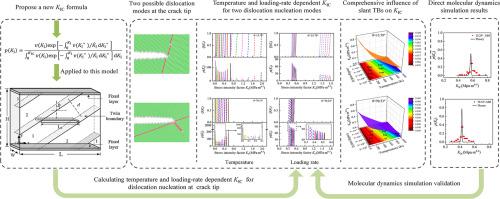当前位置:
X-MOL 学术
›
J. Mater. Sci. Technol.
›
论文详情
Our official English website, www.x-mol.net, welcomes your
feedback! (Note: you will need to create a separate account there.)
Temperature and loading-rate dependent critical stress intensity factor of dislocation nucleation from crack tip: Atomistic insights into cracking at slant twin boundaries in Nano-twinned TiAl alloys
Journal of Materials Science & Technology ( IF 11.2 ) Pub Date : 2024-10-28 , DOI: 10.1016/j.jmst.2024.10.007 Rong Fu, Zhiyuan Rui, Junping Du, Shihao Zhang, Fanshun Meng, Shigenobu Ogata
Journal of Materials Science & Technology ( IF 11.2 ) Pub Date : 2024-10-28 , DOI: 10.1016/j.jmst.2024.10.007 Rong Fu, Zhiyuan Rui, Junping Du, Shihao Zhang, Fanshun Meng, Shigenobu Ogata

|
This paper investigates the temperature and loading rate dependencies of the critical stress intensity factor (KIC) for dislocation nucleation at crack tips. We develop a new KIC formula with a generalized form by incorporating the atomistic reaction pathway analysis into Transition State Theory (TST), which captures the KIC of the first dislocation nucleation event at crack tips and its sensitivity to temperature and loading rates. We use this formula and atomistic modeling information to specifically calculate the KIC for quasi-two-dimensional crack tips located at various slant twin boundaries in nano-twinned TiAl alloys across a wide range of temperatures and strain rates. Our findings reveal that twinning dislocation nucleation at the crack tip dominates crack propagation when twin boundaries (TBs) are tilted at 15.79° and 29.5°. Conversely, when TBs tilt at 45.29°, 54.74°, and 70.53°, dislocation slip becomes the preferred mode. Additionally, at TB tilts of 29.5° and 70.53°, at higher temperatures above 800 K and typical experimental loading rates, both dislocation nucleation modes can be activated with nearly equal probability. This observation is particularly significant as it highlights scenarios that molecular dynamics simulations, due to their time scale limitations, cannot adequately explore. This insight underscores the importance of analyzing temperature and loading rate dependencies of the KIC to fully understand the competing mechanisms of dislocation nucleation and their impact on material behavior.
中文翻译:

与温度和加载速率相关的裂纹尖端位错形核的临界应力强度因子:纳米孪晶 TiAl 合金倾斜孪晶界开裂的原子见解
本文研究了临界应力强度因子 (KIC) 对裂纹尖端位错形核的温度和加载速率依赖性。通过将原子反应途径分析纳入过渡态理论 (TST) 中,我们开发了一种新的广义 KIC 公式,该公式捕获了裂纹尖端第一次位错成核事件的 KIC 及其对温度和负载速率的敏感性。我们使用此公式和原子建模信息来专门计算在很宽的温度和应变速率范围内位于纳米孪晶 TiAl 合金中各种倾斜孪晶界的准二维裂纹尖端的 KIC。我们的研究结果表明,当孪晶界 (TBs) 倾斜 15.79° 和 29.5° 时,裂纹尖端的孪晶位错成核主导了裂纹扩展。相反,当 TBs 倾斜 45.29°、54.74° 和 70.53° 时,位错滑移成为首选模式。此外,在 TB 倾斜 29.5° 和 70.53°、高于 800 K 的较高温度和典型的实验负载速率下,两种位错成核模式可以以几乎相等的概率激活。这一观察结果特别重要,因为它突出了分子动力学模拟由于其时间尺度的限制而无法充分探索的场景。这一见解强调了分析 KIC 的温度和负载速率依赖性的重要性,以充分了解位错成核的竞争机制及其对材料行为的影响。
更新日期:2024-10-29
中文翻译:

与温度和加载速率相关的裂纹尖端位错形核的临界应力强度因子:纳米孪晶 TiAl 合金倾斜孪晶界开裂的原子见解
本文研究了临界应力强度因子 (KIC) 对裂纹尖端位错形核的温度和加载速率依赖性。通过将原子反应途径分析纳入过渡态理论 (TST) 中,我们开发了一种新的广义 KIC 公式,该公式捕获了裂纹尖端第一次位错成核事件的 KIC 及其对温度和负载速率的敏感性。我们使用此公式和原子建模信息来专门计算在很宽的温度和应变速率范围内位于纳米孪晶 TiAl 合金中各种倾斜孪晶界的准二维裂纹尖端的 KIC。我们的研究结果表明,当孪晶界 (TBs) 倾斜 15.79° 和 29.5° 时,裂纹尖端的孪晶位错成核主导了裂纹扩展。相反,当 TBs 倾斜 45.29°、54.74° 和 70.53° 时,位错滑移成为首选模式。此外,在 TB 倾斜 29.5° 和 70.53°、高于 800 K 的较高温度和典型的实验负载速率下,两种位错成核模式可以以几乎相等的概率激活。这一观察结果特别重要,因为它突出了分子动力学模拟由于其时间尺度的限制而无法充分探索的场景。这一见解强调了分析 KIC 的温度和负载速率依赖性的重要性,以充分了解位错成核的竞争机制及其对材料行为的影响。


















































 京公网安备 11010802027423号
京公网安备 11010802027423号